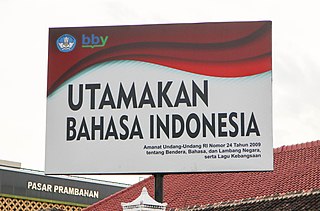Related Research Articles
The Schouten languages are a linkage of Austronesian languages in northern Papua New Guinea. They are in contact with various North Papuan languages, particularly the Skou and some Torricelli languages.
The Senagi languages are a small family of Papuan languages in the classification of Malcolm Ross, that had been part of Stephen Wurm's Trans–New Guinea proposal. They consist of the two languages Angor and Dera.
The Ata language, also known as Pele-Ata after its two dialects, or Wasi, is a Papuan language spoken on New Britain island, Papua New Guinea. It appears to be related to neighboring Anêm, and possibly also to Yélî Dnye in a proposed Yele-West New Britain family. There are about 2000 speakers.
Lungalunga, frequently though ambiguously called Minigir, is spoken by a small number of the Tolai people of Papua New Guinea, who live on the Gazelle Peninsula in East New Britain Province. It is often referred to in the linguistics literature as the Tolai "dialect" with an /s/.

More than 700 living languages are spoken in Indonesia. These figures indicate that Indonesia has about 10% of the world's languages, establishing its reputation as the second most linguistically diverse nation in the world after Papua New Guinea. Most languages belong to the Austronesian language family, while there are over 270 Papuan languages spoken in eastern Indonesia. The language most widely spoken as a native language is Javanese.
The Susuami language is a heavily endangered Papuan language, spoken in the resettlement village of Manki along the upper Watut River, Morobe Province, Papua New Guinea.
Duwet, also known as Guwot or Waing, is an aberrant member of the Busu subgroup of Lower Markham languages in Morobe Province, Papua New Guinea. Duwet is spoken by about 400 people and appears to have been heavily influenced by its neighboring Nabak language of the Papuan Trans–New Guinea languages. It is spoken in the three villages of Lambaip, Lawasumbileng, and Ninggiet.

Papua New Guinea, a sovereign state in Oceania, is the most linguistically diverse country in the world. According to Ethnologue, there are 839 living languages spoken in the country. In 2006, Papua New Guinea Prime Minister Sir Michael Somare stated that "Papua New Guinea has 832 living languages ." Languages with statutory recognition are Tok Pisin, English, Hiri Motu, and Papua New Guinean Sign Language. Tok Pisin, an English-based creole, is the most widely spoken, serving as the country's lingua franca. Papua New Guinean Sign Language became the fourth officially recognised language in May 2015, and is used by the deaf population throughout the country.
The Huon languages are a language family, spoken on the Huon Peninsula of Papua New Guinea, that was classified within the original Trans–New Guinea (TNG) proposal, and William A. Foley considers their TNG identity to be established. They share with the Finisterre languages a small closed class of verbs taking pronominal object prefixes some of which are cognate across both families, strong morphological evidence that they are related.

The Yam languages, also known as the Morehead River languages, are a family of Papuan languages. They include many of the languages south and west of the Fly River in Papua New Guinea and Indonesian West Papua.
Dusner is a language spoken in the village of Dusner in the province of Papua, Indonesia. Dusner is highly endangered, and has been reported to have just three remaining speakers.
Maia is a Papuan language spoken in the Madang Province of Papua New Guinea, and is a member of the Trans-New Guinea language family. It has a language endangerment status of 6a, which means that it is a vigorous and sustainable language spoken by all generations. According to a 2000 census, there are approximately 4,500 living speakers of the language, who are split between twenty-two villages in the Almani district of the Bogia sub-district.
The Tiang language also known as Djaul is a language spoken in Papua New Guinea.
Orokaiva is a Papuan language spoken in the "tail" of Papua New Guinea.
Mandobo, or Kaeti, is a Papuan language of Mandobo District in Boven Digoel Regency, Papua, Indonesia.
Korafe is a Papuan language spoken in Oro Province, in the "tail" of Papua New Guinea. It is part of the Binanderean family of the Trans–New Guinea phylum of languages. Korafe or could also be called Kailikaili, Kaire, Korafe, Korafi, Korape, and Kwarafe is a language spoken in the Oro Province more specifically in the Tufi District, and Cape Nelson Headlands.
Ambel (Amber), also known as Waigeo after the island where it is primarily spoken, is a heavily Papuan-influenced Austronesian language spoken on the island of Waigeo in the Raja Ampat archipelago near the northwestern tip of West Papua, Indonesia. It is spoken by approximately 1,600 people. It is endangered, as the population is shifting to Papuan Malay and few people born after the year 2000 have any knowledge of the language.
Terebu (Turubu) is one of three Kairiru languages spoken in East Sepik Province, Papua New Guinea. It is spoken in Turubu village of Turubu Rural LLG, East Sepik Province.
Mwatebu is an Austronesian language spoken in a single village in the D'Entrecasteaux Islands of Papua New Guinea. It is spoken in the single village of Mwatebu in Duau Rural LLG, Milne Bay Province.
Lenkau is an Oceanic language spoken in a single village on Rambutyo Island in Manus Province, Papua New Guinea. It is spoken in Lenkau village, Rapatona Rural LLG.
References
- ↑ Ono at Ethnologue (18th ed., 2015) (subscription required)